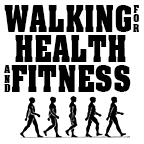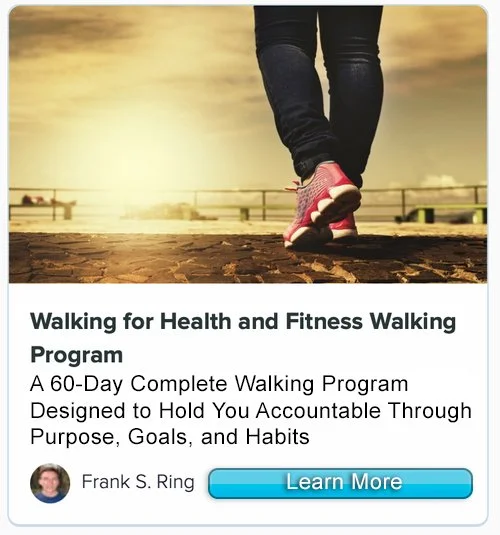“By recording your dreams and goals on paper, you set in motion the process of becoming the person you most want to be. Put your future in good hands—your own.” - Mark Victor Hansen
In this week’s Walking for Health and Fitness podcast, episode 6, I discuss:
· 5 Benefits of Setting Goals
· Why We Fear Setting Goals
· How having a goal helped me get off the couch and complete my virtual walk around the United States.
· Goal Setting Made Simple: Seven Step to Setting Your New Exciting Fitness Goals and taking action on them.
· I’ll also give you Alternatives to Setting Goals because, everyone has a different process and what works for some of you may not work for others.
· Bonus: 10 Ways to Stay Motivated
Get ready to set a long-term goal to keep you fired up and walking for years to come, and a short-term goal that you can accomplish quickly. We all need wins every day and having short term goals gets you more wins. Winning is contagious, the more you win, the more you are inspired to win more.
Setting Fitness Goals
Today’s main topic is getting your body in peak physical condition by setting a fitness goal. Specifically, since this is a walking podcast, you may want to set a goal for a number of steps to take each day, the number of days you walk each week, or the number of miles you walk in a month or over a longer period of time.
The late great Beatle, George Harrison wrote the great song Any Road for his last album, “If you don’t know where you’re going, any road will get you there.”
5 benefits of setting goals:
1. Direction and Focus: Setting goals provides a clear sense of direction and focus. It helps you establish priorities and channel your energy and efforts towards a specific outcome. Goals act as a roadmap, guiding actions and decision-making, ensuring that time and resources are utilized effectively.
2. Motivation and Persistence: Goals serve as powerful motivators. They give you something to strive for, creating a sense of purpose and meaning. Having a goal in mind can ignite intrinsic motivation, enabling you to overcome obstacles, persist through challenges, and stay committed to their aspirations.
3. Measure of Progress: Goals provide a measurable framework for progress evaluation. They enable you to track achievements, celebrate milestones, and identify areas that require improvement. By setting specific and measurable goals, you can objectively assess your growth and development.
4. Personal Growth and Development: Setting goals promotes personal growth and development. It pushes you out of your comfort zones, encourages learning, and fosters the acquisition of new skills and knowledge. Goals challenge you to reach your full potential and expand their capabilities.
5. Sense of Achievement and Fulfillment: Accomplishing a goal boosts self-confidence, enhances self-esteem, and reinforces a belief in one's abilities. Meeting goals provides a tangible sense of success and satisfaction, which can contribute to overall well-being and happiness.
Why do we fear setting goals?
Let me cover two main reasons people fear setting goals:
1. Fear of stepping out of your comfort zone
Firstly, setting goals requires you to step out of your comfort zones and face potential challenges and uncertainties. The fear of failure can be a significant deterrent, as you worry about not being able to achieve your goals or falling short of your own expectations.
This fear can be intensified by societal pressures and the fear of judgment from others. Additionally, setting goals often involves taking risks and making sacrifices, which can trigger fear of the unknown and a reluctance to leave the familiar and secure.
2. Setting goals can bring about a fear of change.
We naturally gravitate towards the familiar and predictable because it provides a sense of stability and security. However, setting goals often involves venturing into uncharted territory, breaking away from routine, and embracing change. This can be uncomfortable and unsettling for individuals who fear the uncertainty and potential disruption that change can bring. Moreover, goals may require you to challenge deeply ingrained beliefs or habits, and this can create resistance due to the fear of losing one's identity or sense of self.
It is important to note that while fear of setting goals is common, it is not insurmountable. By acknowledging and understanding these fears, you can work towards overcoming them by breaking goals into smaller, more manageable steps, seeking support from others, and cultivating a growth mindset that embraces challenges and learning opportunities. We’ll learn more about that in later in the podcast.
Let’s focus on your fitness goals:
· How you can set them: a 7-step plan to setting and achieving any goal.
· How you’ll use them as motivation to take action.
· How you will write them down on paper and read them often and why sharing them is important.
Developing a fitness routine is a major undertaking. Like an archer aiming for the target, having a destination to aim for will keep you on track to reach the health and fitness level you’d like to achieve.
Don’t confuse having a wish with having a goal
Most people think that having a vague idea of what they want and being positive and optimistic about accomplishing it is a goal. This isn’t for you!
Only 3 percent of people have clear, written goals with plans to accomplish them. Only 3 percent of people work on their most important goals each day.
You want to be among the 3 percent!
“If you want a happy life, tie it to goals, not people or things.” - Albert Einstein
Let me break down goal setting made simple and how I applied it to my Virtual Walk Around the United States… Read about it here!
Goal Setting Made Simple
Before you actually “walk” to your goal, you need to take a series of planning steps to dramatically increase the chances that you will be successful.
1. Decide exactly what you want in terms of health and fitness
My initial goal of walking around the United States started as a run to Key West Florida and to use Photoshop to goof on my students. Also, I needed to lose some weight and get back into shape after 2 years of raising my son and all the running around of those elementary school years.
2. Write down your goals and make them measurable
Walking to Florida was the initial goal … approx. 1,350. miles
3. Set a deadline
This I did not do until the end… Dominic… getting there before he graduated in 2020. Covid-19 and disappointed ending.
4. Identify all the obstacles that you will have to overcome to achieve your goals
Making time to run, the overcoming back injury and other nagging leg injuries, then I begin walking due to my back injury. This is where my monthly mileage really increased because I enjoyed walking much more than I ever liked running.
5. Determine the additional knowledge and skills that you will require to achieve your goals
Tying the goal to the maps, then strength training to keep my core strong after my injury.
6. Determine those people whose help and cooperation you will require to achieve your goals
Have the maps put my goal out in the open for students and colleagues to comment on, encourage, and I need to make progress so I had a confident answer for them.
7. Make a list of all your answers to the above, and organize them by sequence and priority
By following these seven steps, you can accomplish any fitness goals that you set for yourself.
Here’s Your Next Step to motivating yourself to take-action.
Set 2 goals for yourself:
1. Set one big long-term goal: Give yourself a compelling reason to get up, get out the door and walk each day.
2. Set one small goal that you can accomplish today: We all need a win every day!
As you walk, use the time to focus on your main goal, specifically:
· How will you feel when you accomplish it?
· What does it taste like, smell like, look like?
· Think about the reward you will give yourself!
Remember: “If you aim for nothing, you'll hit it every time.”
Alternatives to Setting Goals:
Now, after spending a whole blogpost writing about goal setting, let me give you some alternatives. Because, everyone has a different process and what works for me may not work for you. If you are not a goal setting person, then maybe something on this list will have you looking at your goals a little differently. Variety is the spice of life.
1. Flexibility and Adaptability: Not setting specific goals allows for greater flexibility and adaptability in your approach. Without rigid targets, you have the freedom to explore different exercise routines, try new activities, and adjust your workouts based on your changing preferences and circumstances.
2. Reduced Pressure and Stress: Setting goals can sometimes create unnecessary pressure and stress, especially if you constantly feel the need to meet or exceed those goals. By not setting specific targets, you can alleviate the stress associated with performance-based expectations and simply focus on enjoying the process of exercising.
3. Embracing the Journey: Without goals, you can fully embrace the present moment and appreciate the joy of the journey itself. Rather than constantly striving for a specific outcome, you can engage in physical activity for the sheer pleasure of moving your body, improving your fitness, and experiencing the benefits of exercise in the here and now
4. Exploration and Variety: Not having set goals allows you to explore a wider range of physical activities and exercises. You can try different workouts, classes, sports, or outdoor activities without the pressure to achieve a specific result. This exploration can lead to new discoveries, enjoyable experiences, and the ability to find what truly resonates with you.
5. Listening to Your Body: Without goals, you can focus more on listening to your body's cues and responding to its needs. You can prioritize rest and recovery when necessary, modify your workouts based on how you feel each day, and engage in intuitive movement rather than adhering strictly to a predefined plan. This approach promotes a healthier relationship with exercise, where you tune in to your body's signals and prioritize overall well-being.
I hope this give you another perspective on exercise and goal setting.
Bottom line… Just getting out on that walk is a victory and that’s my goal with this podcast; to encourage you, cheerlead you, and show you that walking is the easiest way to get in shape and stay in shape
Walk on,
Frank S. Ring
Author: Walking for Health and Fitness, Fitness Walking and Bodyweight Exercises, Walking Inspiration, and Walking Logbook Journal.







